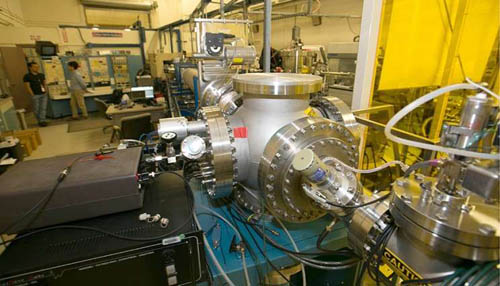
This includes silicon carbide, which is a prototypical nuclear ceramic and wide-band-gap semiconductor material. Understanding mechanisms of the dynamic radiation damage formation in solids remains a major materials physics challenge.

Materials scientists at Lawrence Livermore National Laboratory (LLNL) have developed a novel experimental method to access the dynamic regime of radiation damage formation in nuclear and electronic materials.
Their approach is based on using pulsed ion beams for measurements of defect lifetimes, interaction rates and diffusion lengths.
The creation of stable radiation damage in crystalline solids often occurs during migration and interaction of radiation-generated point defects—lattice vacancies and interstitials. Such dynamic damage formation is a complex phenomenon that could span the spatial range from atomic to macroscopic and the temporal range from femtoseconds to years.
Due to this complexity, a full predictive capability of radiation damage accumulation still does not exist even for the simplest and best studied materials. This includes silicon carbide, which is a prototypical nuclear ceramic and wide-band-gap semiconductor material. Understanding mechanisms of the dynamic radiation damage formation in solids remains a major materials physics challenge.
In a study published in the Aug. 3 edition of Scientific Reports , the team from LLNL and Texas A&M University addressed this challenge by pulsed-ion-beam measurements of the dynamics of defect interaction in silicon carbide. They used LLNL's 4-Mega-electronvolt accelerator to perform pulsed ion-beam irradiation and ion-beam analysis experiments.
The team found that the dominant defect relaxation processes in silicon carbide occur on millisecond time scales.They also found that the defect lifetime in silicon carbide exhibits in a non-monotonic temperature dependence, revealing a major change in the dominant defect interaction mechanism at about 100 degrees Celsius.
"The pulsed-beam method allows us to access the dynamic regime of radiation damage formation, which is essential for predicting the material behavior in different radiation environments," said LLNL material scientist L. Bimo Bayu Aji, the lead author of the paper.
Joseph Wallace, an LLNL scientist said: "The understanding of radiation defect dynamics may suggest new paths to designing radiation-resistant materials."
"The understanding of defect interaction dynamics, probed in our pulsed-beam experiments, also is essential for using laboratory findings for predicting the material behavior under irradiation over time scale relevant to nuclear material service," said Sergei Kucheyev, the LLNL project lead.